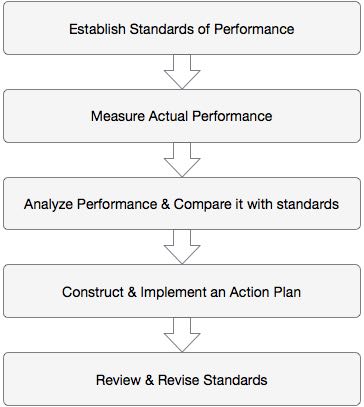
- IB Management Home
- International Trade
- General Agreements On Tariffs & Trade
- World Trade Organization
- Global Trade Major Challenges
- Modern Theories
- Global Competitiveness
- Regional Trading Blocs
- Major Trade Blocs
- Strategic Approaches
- Strategic Compulsions
- Global Portfolio Management
- Modes of Entry
- Organizational Structures
- Control Mechanisms
- Performance Issues
- Business Operations
- Production Issues
- Supply Chain Issues
- Global Marketing Mix
- Financial Aspects
- HRM Issues
- Miscellaneous
- Adverse Effects
- Conflict Management
- Negotiations
- Ethical Issues
- Useful Resources
- Quick Guide
- Useful Resources
- Discussion
Performance Issues
It is an important part of every business organization to measure the performance of both employees and the firm as a whole. We will, however, restrict our focus on organizational performance measurement. The standard process of measuring the performance of a global business is as shown in the following diagram −

The prominent features of each stage are discussed below.
Establish Standard of Performance
Standard of performance is applicable to cost, quality, and customer service. More than one standard may be necessary because they reflect expected levels of various units of the manufacturing performance. This includes process yields, product quality, overhead spending levels, etc.
Measure Actual Performance
To measure actual performance, the use of automated data collection systems is suggested to gather information. A standard cost measurement system includes man-hours, machine-hours, and material usage.
Analyze the Performance and Compare it with standards
There must be some set standards to compare the actual performance. The standards should be realistic and achievable. The results of the comparison can be used to apply further rules, targets, and reporting.
Construct and Implement an Action Plan
Constructing and implementing an action plan is key to success. Variance analysis can be used to detect potential problem areas. Finding the source of the problem and improving the situation may be useful. Its effectiveness depends on the managements adaptability to the information obtained.
Review and Revise Standards
Review and revise is an important step, as modern organizations are in a constant state of change. If the variances are significant, the performance standards can be adjusted. Effective Performance Measurement must be integrated with the overall strategy. This step requires various financial and non-financial indicators.
Effective Performance Measurement System
For getting an effective performance measurement system −
The measurement objectives must be owned and supported throughout the organization.
The process must be applied top-down for maximum benefits. The measures applied must be fair and achievable.
The measurement system and the reporting structure must be simple, clear, and recognizable.
The firms need to prioritize and focus to address only the key performance indicators.
Performance Evaluation System
A performance evaluation system must contain periodic review of operations so that the objectives of the firm are accomplished. It is important to have the accounting information to evaluate domestic and foreign operations costs and profitabilities.
It is not all that simple to measure the performance of an individual, a division, a subsidiary, or even a company as a whole. It is a lengthy and hectic process. The objectives of performance evaluation are to −
- Find the economic performance of the firm
- Analyze each units management performance
- Monitor the progress of objectives, including the strategic goals
- Assist in appropriate allocation of resources
Financial and Non-Financial Measures of Evaluation
ROI (Return on Investment) − ROI is the most common method to evaluate the performance of an international firm. It shows the relationship between profit to invested capital and encompasses almost all important factors related to performance. An improved ROI can act as a logical motivator of the managers.
Budget as Success Indicator − Budget is an accepted tool for measuring and controlling the operations. It is also used to forecast future operations. A budget is a clearly expressed set of objectives that guide the managers to set their individual performance standards. A good local or regional budget helps the company to facilitate its strategic planning process smoothly.
Non-Financial Measures − The major non-financial measures that can be used to evaluate performance are − Market Share, Exchange Variations, Quality Control, Productivity Improvement, and Percentage of Sales.
Types of Performance Evaluation Systems
Performance evaluation systems can be of the following types −
Budget Programming − Budget programming is prepared for operational planning and financial control. It is an easy-to-calculate system to evaluate the variance. It is used to measure the current performance in relation to some comparable performance metric from the past.
Management Audit − It is an extended form of financial audit system which monitors the quality of management decisions in financial operations. It is used for appraisal and performing audit for management.
Programme Evaluation Review Technique (PERT) − Based on CPM, PERT delineates a given project or program into network of activities or sub-activities. The goal is to optimize the time spent by the managers. In this process, performance is measured by comparing the scheduled time and the cost allocated with the actual time and the cost.
Management Information System (MIS) − MIS is an ongoing system designed to plan, monitor, control, appraise, and redirect the management towards pre-defined targets and goals. It is a universally acceptable practice which encompasses the financial, budgeting, audit and control systems of the PERT.